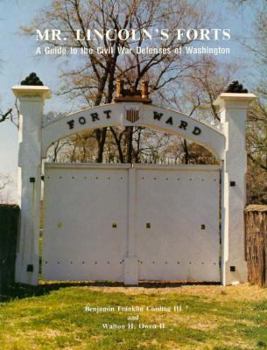Mr. Lincoln's Forts: A Guide to the Civil War Defenses of Washington
No Synopsis Available.
Format:Hardcover
Language:English
ISBN:0942597052
ISBN13:9780942597059
Release Date:April 1989
Publisher:White Mane Publishing Company
Length:256 Pages
Weight:2.44 lbs.
Dimensions:0.9" x 8.8" x 11.3"
Customer Reviews
1 rating
MR. LINCOLN'S FORTS: A GUIDE TO THE CIVIL WAR DEFENSES OF WASHINGTON-NEW EDITION
Published by Thriftbooks.com User , 14 years ago
MR. LINCOLN'S FORTS: A GUIDE TO THE CIVIL WAR DEFENSES OF WASHINGTON-NEW EDITION BENJAMIN F. COOLING III AND WALTON H. OWEN II THE SCARECROW PRESS, 2009 QUALITY SOFTCOVER, $50.00, 334 PAGES, APPENDICES, NOTES, BIBLIOGRAPHY, INDEX, PHOTOGRAPHS, MAPS, ILLUSTRATIONS At the outbreak of The War Between The States, the U.S. Government faced many daunting problems, but the one closest to home was the situation and character of the national capital. Maryland had donated the ten-square-mile tract designated as the District of Columbia in the 1790s, when plans were made to move the capital to a Southern location. Still new and raw when the government moved operations there at the turn of the 19th Century, it remained more a plan than a realization even at mid-century. Aside from its unfinished appearance, the most striking feature about the city was its Southern character. Some feared, and others hoped, that the characteristics would translate into Southern sympathies. After the attack on Fort Sumter and Lincoln had called for volunteers, local militia was bolstered by the arrival of the 6th Massachusetts Infantry-the same regiment harassed by a Baltimore mob while changing trains in that city-but effectiveness was still low considering the capital's defensive requirements. Colonel Charles P. Stone (the first organizer of the capital's defenses) proposed to General Winfield Scott that if Washington were invaded he would defend the Capitol, the Patent Office, Post Office, and the Executive buildings, including the president's house. Scott insisted that the plan was too ambitious for the numbers at Stone's disposal. They could defend only Executive Square, said Scott, and they could only do that from the Treasury Building where a reliable water supply and stored food would allow the president and his cabinet to hole up indefinitely. Scott had a point. The city spanned a broad front across the point of the "V" formed by the Potomac and Anacostia Rivers, the latter sometimes called the Eastern Branch, and was easily approachable from a variety of directions. On the southwest, Long Bridge crossed the Potomac linking the Alexandria Road to Maryland Avenue; on the southeast, the Navy Yard Bridge crossed the Eastern Branch from Maryland. True, these could be defended with relative ease and even destroyed if necessary, but the wide arc of northern approaches was another matter. The railroad from Baltimore entered the city from the northeast, crossing the city limits at Boundary Street (currently Florida Avenue) to the railroad station three blocks north of the Capitol. The 7th Street Road headed straight north toward the Soldier's Home (a favorite retreat for Lincoln) and Silver Spring. Bridges across Rock Creek west of town linked the capital with Georgetown. Also above Georgetown there was Chain Bridge, which spanned the Potomac on the road from Harper's Ferry and Leesburg. When the rebellion wasn't crushed early, a strong fortress ring had to be developed to d





